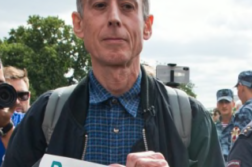Editor’s note: This piece follows up on a feature article by Pawel Leszkowicz on gay art and politics in Poland in the G&LR’s May-June 2003 issue.
On December 11, 2003, politicians and skinheads picketed the Jagiellonian University of Krakow, Poland, where students were holding a meeting about a bill to legalize same-sex unions. Their target was the keynote speaker of the meeting, senator of Polish Parliament Maria Szyszkowska. In ultraconservative Poland, she authored and proposed to the Senate a bill supporting same-sex partnership. Under the law, same-sex couples would be able to register their partnership and be entitled to economic rights in taxation, insurance, and succession, but no adoption to same-sex unions. Section 4 of the bill recognizes that same-sex partners come together for emotional support and spiritual understanding. Granting a legal status to same-sex unions would mark a breakthrough in post-Communist Poland. The fact that there’s official discussion about such a bill is itself a democratic advance.
The leader of All Polish Youth called Senator Szyszkowska a “witch” and presented her with a broom—a return to a medieval image that’s both misogynist and homophobic. All Polish Youth is a youth militia of the League of Polish Families that has representation in Polish parliament and its own media outlets. The group turns Catholicism into a form of religious fundamentalism: they are anti-abortion, anti-European Union, anti-foreigner, and anti-gay. Earlier this year, the group forced the mayor of Krakow to ban the billboard campaign “Let us be seen,” which presented portraits of gay and lesbian couples holding hands [see Pawel Leszkowicz’s piece in the May-June 2003 issue of this journal]. Poland’s biggest daily, Gazeta Wyborcza, covered the incident in a non-homophobic way. In 2002 the paper had featured a discussion about homosexuality that embraced hostile as well as supportive views, including an article by a conservative psychologist about conversion therapy. But this year Gazeta Wyborcza has been friendlier to GLBT issues. The coverage included a photograph of a banner carried by members of the League of Polish Families that read, with predictable venom: “Sodom, Gomorrah, Szyszkowska.”
Like Shirin Ebadi, who just accepted the Nobel Prize for her fight for human rights in Iran, Maria Szyszkowska is a lawyer, lecturer, and activist. Now a senator in Poland’s parliament, Szyszkowska has always rebelled against the status quo. Under Communism, she was the only philosopher of law, an outlawed discipline, and she was unable to find a teaching position under martial law in the early 1980’s. Besides initiating the law to legalize same-sex partnerships, Szyszkowska also participates enthusiastically in a series of meetings at Polish universities, “I am gay. I am lesbian. Meet us.”
Women are spearheading the drive for gay rights in Poland. Photographer Karolina Bregula authored a project of public art, coordinated by an NGO Campaign Against Homophobia. Billboards in Polish cities showed her portraits of same-sex couples holding hands. Some of the billboards were painted over by vandals. This is why the portraits were shown mainly in galleries. Exhibitions of Bregula’s photographs were very successful in Warsaw, Gdansk, Wroclaw, Sosnowiec, and Krakow.
Women’s participation is especially significant because homophobia is combined with misogyny in Poland. Abortion is banned here, and there are a number of cultural and economic constraints on women and GLBT people alike. Censorship imposed on feminist and queer art is of a piece with political pressure on women artists any time they deal with the matters of sexuality. Like Bregula’s photograph campaign, art by women often carries a social message, critical of mainstream politics, and it becomes the butt of violent attacks and political opposition. Mayors of Polish cities spoke out against the billboards in the “Let us be seen” campaign.
The League of Polish Families threatened a woman artist, Dorota Nieznalska, who depicted a penis on a cross in a work of installation art aimed at exploring masculinity and suffering. Members of the party attacked Nieznalska verbally and physically in a Gdansk gallery. The League sued her, and the artist was found guilty of “offending religious feelings” of Polish citizens and sentenced to a half-year of “restriction of freedom in the form of penal labor,” as it was worded. Nieznalska was specifically banned from foreign travel for fear that this would boost her international standing. When the judge read the sentence, the members of the League of Polish Families applauded ecstatically. The lawsuit prompted intellectuals to circulate a letter of protest, which read in part: “Polish society is not homogeneous. We can talk about majorities and minorities belonging to the same society. Dorota Nieznalska, in dealing with one of the problems which are present in this society, is expressing her right to be different.”
Despite discrimination in the law and gay-bashing in the streets, the GLBT movement in Poland is growing. Lesbian and gay writers like Izabela Filipiak are beginning to emerge, and research in queer studies is blooming. Scholars in the latter discipline will be convening for the fifth international conference in Wroclaw this spring. If anything, opposition from groups like the League of Polish Families only strengthens our resolve.




